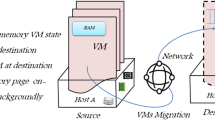Abstract
The ever-growing intricacy and dynamicity of Cloud Computing Systems has created a need for Proactive Load Balancing which is an effective approach to improve the scalability of today’s Cloud services. In order to manage the load proactively on the Cloud system during application execution, load should be predicted through machine learning approaches and handled through VM migration approaches. Thus, this paper formulates an effort to focus on the research problem of designing a prediction-based approach for facilitating proactive load balancing through the prediction of multiple resource utilization parameters in Cloud. The involvement of this paper is twofold. Firstly, various machine learning approaches have been tested and compared for predicting host overutilization as well as underutilization. Secondly, the load prediction model having maximum accuracy from the tested models has been utilized for implementing the proactive VM migration using multiple resource utilization parameters. Further, the proposed technique has been validated through performance evaluation parameters using CloudSim and Weka toolkits. The simulation results clearly demonstrate that the proposed approach is effective for handling VM migration, reducing SLA Violations, VM migrations, execution mean and standard deviation time.









Similar content being viewed by others
References
Armbrust M, Fox A, Griffith R, Joseph AD, Katz R (2009) Above the Clouds: a Berkeley view of Cloud Computing. Commun ACM 53(4):1–25
Zhang Q, Cheng L, Boutaba R (2010) Cloud Computing: state-of-the-art and research challenges. J Internet Serv Appl 1:7–18
Calheiros RN, Ranjan R, Beloglazov A, Rose CAFD, Buyya R (2011) CloudSim: a toolkit for modelling and simulation of Cloud Computing environments and evaluation of resource provisioning algorithms. Softw Pract Exp 41:23–50
Beloglazov A, Buyya R (2012) Optimal online deterministic algorithms and adaptive heuristics for energy and performance efficient dynamic consolidation of virtual machines in Cloud data centers. J Concurr Comput Pract Exp 24:1397–1420
Silva JN, Veiga L, Ferreira P (2008) Heuristic for resources allocation on utility computing infrastructures. In: MGC08 proceedings of the 6th international workshop on middleware for grid computing. ACM, New York, NY, USA, p 16
Lim HC, Babu S, Chase JS, Parekh SS (2009) Automated control in Cloud Computing: challenges and opportunities. In: ACDC09: proceedings of the 1st workshop on automated control for datacenters and Clouds. ACM, New York, NY, USA, p 1318
Caron E, Desprez F, Muresan A (2010) Forecasting for Cloud Computing on-demand resources based on pattern matching. Technical Report, INRIA
Kupferman J, Silverman J, Jara P, Browne J (2010) Scaling into the Cloud. Advanced Operating System, p 1–10. http://cs.ucsb.edu/jkupferman/docs/ScalingIntoTheClouds.pdf
Catal C, Diri B (2009) A systematic review of software fault prediction studies. Expert Syst Appl 36:7346–7354
Islam S, Keunga J, Lee K, Liu A (2012) Empirical prediction models for adaptive resource provisioning in the cloud. Future Gener Comput Syst 28:155–162
Kousiouris G, Menychtasa A, Kyriazis D, Gogouvitis S, Varvarigou T (2014) Dynamic, behavioural-based estimation of resource provisioning based on high-level application terms in Cloud platforms. Future Gener Comput Syst 32:27–40
Ren X, Lin R, Zou H (2011) A dynamic load balancing strategy for Cloud Computing platform based on exponential smoothing forecast. In: Proceedings of IEEE CCIS2011, pp 220–224
Aniello L, Bonomi S, Lombardi F, Zelli A, Baldoni R (2014) An architecture for automatic scaling of replicated services. In: Noubir G, Raynal M (eds) Networked Systems. Springer, Lecture Notes in Computer Science, pp 122–137
Bala A, Chana I (2014) Intelligent failure prediction models for scientific workflows. Expert Syst Appl 42(3):980–989
Abdi H (2007) Multiple correlation coefficients. In: Salkind NJ (ed) Encyclopedia of measurement and statistics. Sage, Thousand Oaks, CA, USA, pp 648–651
Bala A, Chana I (2013) VM migration approach for autonomic fault tolerance in Cloud Computing. In: International conference of grid and Cloud applications GCA13. Las Vegas, USA, pp 3–10
Bala A, Chana I (2014) Autonomic fault tolerant scheduling approach for scientific workflows in Cloud Computing. Concurr Eng Res Appl Sage Publ (Accepted)
Hall M, Frank E, Holmes G, Pfahringer B, Reutemann P, Witten IH (2009) The WEKA data mining software: an update. SIGKDDExplorations 11:10–18
Guo L, Ma Y, Cukic B, Singh H (2004) Robust prediction of fault-proneness by random forests. In: Proceedings of the 15th international symposium on software reliability engineering, pp 417–428
Salfner F, Lenk M, Malek M (2010) A survey of online failure prediction methods. ACM Comput Surv 42:1–42
Malhotra R, Jain A (2012) Fault prediction using statistical and machine learning methods for improving software quality. J Inf Process Syst 8:241–262
Aggarwal KK, Singh Y, Kaur A, Malhotra R (2009) Empirical analysis for investigating the effect of object-oriented metrics on fault proneness: a replicated case study. Softw Process Improv Pract 16:39–62
Author information
Authors and Affiliations
Corresponding author
Rights and permissions
About this article
Cite this article
Bala, A., Chana, I. Prediction-based proactive load balancing approach through VM migration. Engineering with Computers 32, 581–592 (2016). https://doi.org/10.1007/s00366-016-0434-5
Received:
Accepted:
Published:
Issue Date:
DOI: https://doi.org/10.1007/s00366-016-0434-5




